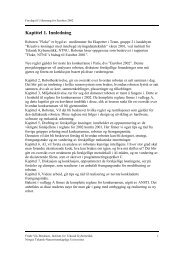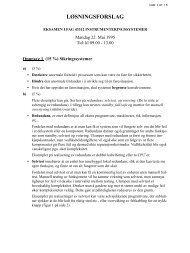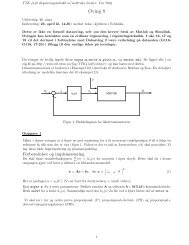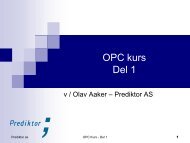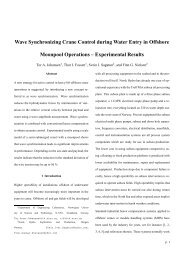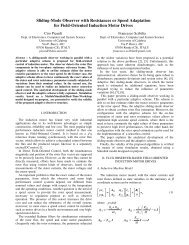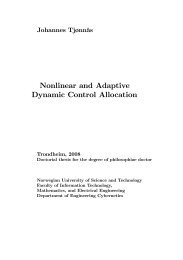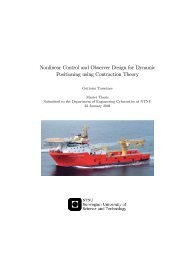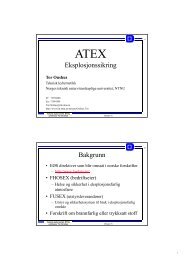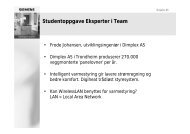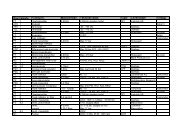Lecture Notes TTK 4190 Guidance and Control of - NTNU
Lecture Notes TTK 4190 Guidance and Control of - NTNU
Lecture Notes TTK 4190 Guidance and Control of - NTNU
Create successful ePaper yourself
Turn your PDF publications into a flip-book with our unique Google optimized e-Paper software.
<strong>Lecture</strong> <strong>Notes</strong>:<br />
<strong>TTK</strong> <strong>4190</strong> <strong>Guidance</strong> <strong>and</strong> <strong>Control</strong> <strong>of</strong> Vehicles<br />
Thor I. Fossen<br />
Pr<strong>of</strong>essor <strong>of</strong> <strong>Guidance</strong>, Navigation <strong>and</strong> <strong>Control</strong><br />
Department <strong>of</strong> Engineering Cybernetics<br />
Norwegian University <strong>of</strong> Science <strong>and</strong> Technology (<strong>NTNU</strong>)<br />
NO-7491 Trondheim<br />
Norway<br />
1<br />
<strong>Lecture</strong> <strong>Notes</strong> <strong>TTK</strong> <strong>4190</strong> <strong>Guidance</strong> <strong>and</strong> <strong>Control</strong> <strong>of</strong> Vehicles (T. I. Fossen)
Practical Information<br />
- It’s learning<br />
- WIKI page: http://www.itk.ntnu.no/emner/ttk<strong>4190</strong><br />
Teaching Assistant: Anastasios Lekkas<br />
E-mail: Anastasios.Lekkas@itk.ntnu.no<br />
Student Assistant: Kristian Klausen<br />
E-mail: krisklau@stud.ntnu.no<br />
2<br />
<strong>Lecture</strong> <strong>Notes</strong> <strong>TTK</strong> <strong>4190</strong> <strong>Guidance</strong> <strong>and</strong> <strong>Control</strong> <strong>of</strong> Vehicles (T. I. Fossen)
Compulsory Text<br />
Compulsory Text:<br />
Fossen, T. I. (2011)<br />
H<strong>and</strong>book <strong>of</strong> Marine Craft Hydrodynamics<br />
<strong>and</strong> Motion <strong>Control</strong>. John Wiley & Sons Ltd.<br />
Fossen, T. I. (2013).<br />
Mathematical Models for <strong>Control</strong> <strong>of</strong><br />
Aircraft <strong>and</strong> Satellites. Department <strong>of</strong><br />
Engineering Cybernetics, <strong>Lecture</strong> <strong>Notes</strong>.<br />
3<br />
<strong>Lecture</strong> <strong>Notes</strong> <strong>TTK</strong> <strong>4190</strong> <strong>Guidance</strong> <strong>and</strong> <strong>Control</strong> <strong>of</strong> Vehicles (T. I. Fossen)
Useful References<br />
Fossen, T. I. (1994). “<strong>Guidance</strong> <strong>and</strong> <strong>Control</strong> <strong>of</strong><br />
Ocean Vehicles”, John Wiley & Sons Ltd.<br />
ISBN 0-471-94113-1<br />
SNAME (1950). Nomenclature for Treating<br />
the Motion <strong>of</strong> a Submerged Body Through a<br />
Fluid. The Society <strong>of</strong> Naval Architects <strong>and</strong><br />
Marine Engineers, Technical <strong>and</strong> Research<br />
Bulletin No. 1-5, April 1950, pp. 1-15.<br />
y b<br />
p<br />
u ( surge)<br />
x b<br />
v ( sway)<br />
( roll)<br />
q<br />
( pitch)<br />
r ( yaw)<br />
w ( heave)<br />
z b<br />
4<br />
<strong>Lecture</strong> <strong>Notes</strong> <strong>TTK</strong> <strong>4190</strong> <strong>Guidance</strong> <strong>and</strong> <strong>Control</strong> <strong>of</strong> Vehicles (T. I. Fossen)
Goals for the Course:<br />
1. Mathematical modeling<br />
<strong>of</strong> vehicles. This<br />
includes:<br />
• Kinematics<br />
• Kinetics<br />
• Equations <strong>of</strong> motion<br />
for marine craft <strong>and</strong><br />
aircraft<br />
• Wind, wave <strong>and</strong><br />
ocean current<br />
models<br />
• Hydrodynamics:<br />
maneuvering <strong>and</strong><br />
seakeeping theory<br />
Copyright © Bjarne Stenberg/<strong>NTNU</strong><br />
2. Design <strong>of</strong> guidance, navigation <strong>and</strong> motion control systems for a large<br />
number <strong>of</strong> applications<br />
3. Simulate the motions <strong>of</strong> marine craft <strong>and</strong> aircraft in the time-domain using<br />
hydrodynamic/aerodynamic models<br />
5<br />
<strong>Lecture</strong> <strong>Notes</strong> <strong>TTK</strong> <strong>4190</strong> <strong>Guidance</strong> <strong>and</strong> <strong>Control</strong> <strong>of</strong> Vehicles (T. I. Fossen)
6 <strong>TTK</strong> <strong>4190</strong> <strong>Guidance</strong> <strong>and</strong> <strong>Control</strong> (T. I. Fossen)
Marine Craft in Operation<br />
Geological<br />
survey<br />
Position<br />
mooring<br />
Pipe <strong>and</strong> cable<br />
laying<br />
Heavy lift<br />
operations<br />
ROV operations<br />
Cable-laying<br />
vessel<br />
Vibration<br />
control<br />
<strong>of</strong> marine<br />
risers<br />
7 <strong>TTK</strong> <strong>4190</strong> <strong>Guidance</strong> <strong>and</strong> <strong>Control</strong> (T. I. Fossen) <strong>Lecture</strong> <strong>Notes</strong> 2005<br />
Pipe-laying vessel
Marine Craft in Operation<br />
8<br />
<strong>Lecture</strong> <strong>Notes</strong> <strong>TTK</strong> <strong>4190</strong> <strong>Guidance</strong> <strong>and</strong> <strong>Control</strong> <strong>of</strong> Vehicles (T. I. Fossen)<br />
Copyright © Bjarne Stenberg/<strong>NTNU</strong>
Path Following <strong>and</strong> Trajectory Tracking<br />
Fully actuated supply ship cruising at low speed.<br />
Underactuated container ship in transit.<br />
Italian supply ship Vesuvio<br />
refueling two ships at sea.<br />
Courtesy: Hepburn Eng. Inc.<br />
9<br />
<strong>Lecture</strong> <strong>Notes</strong> <strong>TTK</strong> <strong>4190</strong> <strong>Guidance</strong> <strong>and</strong> <strong>Control</strong> <strong>of</strong> Vehicles (T. I. Fossen)
Formation <strong>Control</strong>/Underway Replenishment<br />
10<br />
<strong>Lecture</strong> <strong>Notes</strong> <strong>TTK</strong> <strong>4190</strong> <strong>Guidance</strong> <strong>and</strong> <strong>Control</strong> <strong>of</strong> Vehicles (T. I. Fossen)
Interdisciplinary: Rocket Launch / DP system / THCS<br />
Courtesy: SeaLaunch LLC<br />
11<br />
<strong>Lecture</strong> <strong>Notes</strong> <strong>TTK</strong> <strong>4190</strong> <strong>Guidance</strong> <strong>and</strong> <strong>Control</strong> <strong>of</strong> Vehicles (T. I. Fossen)<br />
Marine Segment<br />
SM<br />
Courtesy: SeaLaunch<br />
http://www.sea-launch.com
Trim & Heel Correction System (THCS)<br />
Process <strong>and</strong><br />
Marine <strong>Control</strong><br />
12<br />
<strong>Lecture</strong> <strong>Notes</strong> <strong>TTK</strong> <strong>4190</strong> <strong>Guidance</strong> <strong>and</strong> <strong>Control</strong> <strong>of</strong> Vehicles (T. I. Fossen)
<strong>NTNU</strong> Infrastructure<br />
13<br />
Copyright © Bjarne Stenberg/<strong>NTNU</strong>
Towing Tests <strong>of</strong> Ships <strong>and</strong> Floating Structures<br />
– Optimisation <strong>of</strong> hull resistance<br />
with <strong>and</strong> without waves<br />
– Identification <strong>of</strong> hydrodynamic<br />
parameters by:<br />
• Planar Motion<br />
Mechanism (PMM) tests<br />
• Vertical Motion<br />
Mechanism (VMM) tests<br />
Model testing in Peerlesspool in London<br />
14<br />
<strong>Lecture</strong> <strong>Notes</strong> <strong>TTK</strong> <strong>4190</strong> <strong>Guidance</strong> <strong>and</strong> <strong>Control</strong> <strong>of</strong> Vehicles (T. I. Fossen)
GNC Laboratory: Replaced by MCLab<br />
Cybership I<br />
15
Marine Cybernetics Laboratory (MCLab)<br />
MCLab Dimensions:<br />
L B D 40 m 6.5 m 1.5 m<br />
The s<strong>of</strong>tware is developed by using<br />
rapid prototyping techniques <strong>and</strong><br />
automatic code generation under<br />
Matlab/Simulink <strong>and</strong> RT-Lab.<br />
The target PC onboard the model<br />
scale vessels runs the QNX real-time<br />
operating system, while experimental<br />
results are presented in real-time on a<br />
host PC using Labview.<br />
Cybership II<br />
16<br />
<strong>Lecture</strong> <strong>Notes</strong> <strong>TTK</strong> <strong>4190</strong> <strong>Guidance</strong> <strong>and</strong> <strong>Control</strong> <strong>of</strong> Vehicles (T. I. Fossen)
Applied Underwater Robotics Laboratory<br />
AUR-Lab<br />
18<br />
<strong>NTNU</strong> Research Groups:<br />
• Department <strong>of</strong> Marine Technology<br />
• Department <strong>of</strong> Biology incl. UNIS <strong>and</strong> CalPoly<br />
• Department for Archaeology <strong>and</strong> Religious Studies<br />
• Department <strong>of</strong> Engineering Cybernetics<br />
• Centre for Autonomous Marine Operations <strong>and</strong> Systems<br />
(AMOS)<br />
Scientific Focus Areas:<br />
• Development <strong>of</strong> technology for guidance, navigation <strong>and</strong><br />
control <strong>of</strong> underwater vehicles (ROVs <strong>and</strong> AUVs)<br />
• Environmental monitoring <strong>and</strong> mapping at sea surface,<br />
water column, <strong>and</strong> sea bed<br />
• Operations under ice in the arctic<br />
• Study <strong>of</strong> any object <strong>of</strong> interest (bio-geo-chemical objects)<br />
• Inspection/surveillance for environmental agencies, oil<br />
industry, ecotoxicology<br />
• Deepwater archaeology<br />
• Deepwater ecology research<br />
• Complex deepwater underwater operations including<br />
inspection <strong>and</strong> intervention<br />
• Deepwater mineral extraction<br />
ROV Minerva<br />
AUV REMUS 100 at<br />
Svalbard<br />
RV Gunnerus
<strong>NTNU</strong> Research Vessel Gunnerus<br />
31 meters long<br />
Top speed 13 knots<br />
http://www.ntnu.edu/marine/gunnerus<br />
19
<strong>NTNU</strong> Unmanned Aerial Vehicle (UAV)<br />
The Odin Aero Recce 6<br />
equipped with the FCS-20<br />
flight control system <strong>and</strong><br />
a camera system<br />
Wing span approx. 1.5m<br />
Range = 45 min<br />
Flight control system FCS-20 by<br />
Adaptive Flight Inc., Atlanta.<br />
The FCS-20 is also delivered<br />
as a s<strong>of</strong>tware development<br />
kit <strong>and</strong> embedded in a<br />
training simulator<br />
24
Marine Craft<br />
Ref. Encyclopedia Britannica<br />
Marine craft: ships, high-speed craft, semi-submersibles, floating rigs, submarines, remotely<br />
operated <strong>and</strong> autonomous underwater vehicles, torpedoes <strong>and</strong> other propelled/powered<br />
structures for instance a floating air field.<br />
Vehicles that do not travel on l<strong>and</strong> (ocean <strong>and</strong> flight vehicles) are usually called craft.<br />
Vessel: "hollow structure made to float upon the water for purposes <strong>of</strong> transportation <strong>and</strong><br />
navigation; especially, one that is larger than a rowboat ".<br />
The words vessel, ship <strong>and</strong> boat are <strong>of</strong>ten used interchangeably. In Encyclopedia Britannica, a<br />
ship <strong>and</strong> a boat are distinguished by their size through the following definition:<br />
Ship: "any large floating vessel capable <strong>of</strong> crossing open waters, as opposed to a boat, which is<br />
generally a smaller craft. The term formerly was applied to sailing vessels having three or more<br />
masts; in modern times it usually denotes a vessel <strong>of</strong> more than 500 tons <strong>of</strong> displacement.<br />
Submarine: "any naval vessel that is capable <strong>of</strong> propelling itself beneath the water as well as<br />
on the water's surface. This is a unique capability among warships, <strong>and</strong> submarines are quite<br />
different in design <strong>and</strong> appearance from surface ships<br />
32<br />
Underwater Vehicle: "small vehicle that is capable <strong>of</strong> propelling itself beneath the water<br />
surface as well as on the water's surface. This includes unmanned underwater vehicles (UUV),<br />
remotely operated vehicles (ROV) <strong>and</strong> autonomous underwater vehicles (AUV).<br />
<strong>Lecture</strong> <strong>Notes</strong> <strong>TTK</strong> <strong>4190</strong> <strong>Guidance</strong> <strong>and</strong> <strong>Control</strong> <strong>of</strong> Vehicles (T. I. Fossen)
Marine Craft<br />
Marine vessels are also classified according to their maximum operating speed. For this<br />
purpose it is common to use the Froude number<br />
Fn <br />
U gL<br />
U: ship speed<br />
L: overall (submerged length <strong>of</strong> the ship)<br />
G: acceleration <strong>of</strong> gravity<br />
The pressure carrying the vessel can be divided into hydrostatic <strong>and</strong> hydrodynamic<br />
pressure. The corresponding forces are:<br />
• Buoyancy force due to the hydrostatic pressures<br />
(proportional to the displacement <strong>of</strong> the ship)<br />
• Hydrodynamic force due to the hydrodynamic pressure<br />
(approximately proportional to the square <strong>of</strong> the speed)<br />
Then we can classify the vessels according to (Faltinsen 2005):<br />
• Displacement vessels (Fn1.0-1.2): The hydrodynamic force mainly carries the weight.<br />
In this course, only displacement<br />
vessels are covered<br />
33<br />
<strong>Lecture</strong> <strong>Notes</strong> <strong>TTK</strong> <strong>4190</strong> <strong>Guidance</strong> <strong>and</strong> <strong>Control</strong> <strong>of</strong> Vehicles (T. I. Fossen)
Degrees-<strong>of</strong>-Freedom (DOF)<br />
y b<br />
sway<br />
roll<br />
pitch<br />
yaw<br />
In maneuvering, a marine craft experiences motion<br />
in 6 DOF. The motion in the horizontal plane is<br />
referred to as surge (longitudinal motion, usually<br />
superimposed on the steady propulsive motion) <strong>and</strong><br />
sway (sideways motion).<br />
Heading, or yaw (rotation about the vertical axis)<br />
describes the course <strong>of</strong> the vessel. The remaining<br />
three DOFs are roll (rotation about the longitudinal<br />
axis), pitch (rotation about the transverse axis), <strong>and</strong><br />
heave (vertical motion).<br />
surge<br />
x b<br />
z b<br />
heave<br />
Roll is probably the most troublesome DOF, since it<br />
produces the highest accelerations <strong>and</strong>, hence, is<br />
the principal villain in seasickness. Similarly, pitching<br />
<strong>and</strong> heaving feel uncomfortable to humans.<br />
34<br />
<strong>Lecture</strong> <strong>Notes</strong> <strong>TTK</strong> <strong>4190</strong> <strong>Guidance</strong> <strong>and</strong> <strong>Control</strong> <strong>of</strong> Vehicles (T. I. Fossen)<br />
When designing ship autopilots, yaw is the primary<br />
mode for feedback control. Stationkeeping <strong>of</strong> a<br />
marine craft implies stabilization <strong>of</strong> the surge, sway<br />
<strong>and</strong> yaw modes.
Degrees <strong>of</strong> Freedom (DOF)<br />
When designing feedback control systems for marine vessels, reduced order models are <strong>of</strong>ten used<br />
since most vehicles do not have actuation in all DOF. This is usually done by decoupling the motions <strong>of</strong><br />
the vessel according to:<br />
1-DOF models can be used to design forward speed controllers (surge), heading autopilots (yaw) <strong>and</strong><br />
roll damping systems (roll).<br />
3-DOF models are usually:<br />
∙ Horizontal plane models (surge, sway <strong>and</strong> yaw) for ships, semi-submersibles <strong>and</strong> underwater vehicles<br />
that are used in dynamic positioning systems, trajectory-tracking control systems <strong>and</strong> path-following<br />
systems. For slender bodies like submarines, it is also common to assume that the motions can be<br />
decoupled into longitudinal <strong>and</strong> lateral motions.<br />
∙ Longitudinal models (surge, heave <strong>and</strong> pitch) for forward speed, diving <strong>and</strong> pitch control.<br />
∙ Lateral model (sway, roll <strong>and</strong> yaw) for turning <strong>and</strong> heading control.<br />
4-DOF models (surge, sway, roll <strong>and</strong> yaw) are usually formed by adding the roll equation to the 3 DOF<br />
horizontal plane model. These models are used in maneuvering situations where it is important to<br />
include the rolling motion usually with the purpose <strong>of</strong> reducing roll by active control <strong>of</strong> fins, rudders or<br />
stabilizing liquid tanks.<br />
35<br />
6-DOF models (surge, sway, heave, roll, pitch <strong>and</strong> yaw) are fully coupled equations <strong>of</strong> motion used for<br />
simulation <strong>and</strong> prediction <strong>of</strong> coupled vessel motions. These models can also be used in advanced<br />
control systems for underwater vehicles which can be actuated in all DOF.<br />
<strong>Lecture</strong> <strong>Notes</strong> <strong>TTK</strong> <strong>4190</strong> <strong>Guidance</strong> <strong>and</strong> <strong>Control</strong> <strong>of</strong> Vehicles (T. I. Fossen)
Classification <strong>of</strong> Models<br />
Simulation Model: This model is the most<br />
accurate description <strong>of</strong> a system, for instance<br />
a 6-DOF high-fidelity model for simulation <strong>of</strong><br />
coupled motions in the time domain. It<br />
includes the marine craft dynamics,<br />
propulsion system, measurement system <strong>and</strong><br />
the environmental forces due to wind, waves<br />
<strong>and</strong> ocean currents.<br />
The model should be able to reconstruct the<br />
time responses <strong>of</strong> the real system <strong>and</strong> it<br />
should also be possible to trigger failure<br />
modes so you can simulate accidents <strong>and</strong><br />
erroneous signals etc. Simulation models<br />
where the fluid memory effects are included<br />
(frequency-dependent models) typically<br />
consist <strong>of</strong> 50-200 ODEs while a frequencyindependent<br />
model can be represented in 6<br />
DOF with 12 ODEs for generalized position<br />
<strong>and</strong> velocity.<br />
36<br />
<strong>Lecture</strong> <strong>Notes</strong> <strong>TTK</strong> <strong>4190</strong> <strong>Guidance</strong> <strong>and</strong> <strong>Control</strong> <strong>of</strong> Vehicles (T. I. Fossen)<br />
In addition you need some states to describe<br />
the environmental loads <strong>and</strong> actuators but<br />
still the number <strong>of</strong> states will be less than 50<br />
for a frequency-independent vessel model
Classification <strong>of</strong> Models<br />
<strong>Control</strong> Design Model: The controller model is a reduced-order or simplified version <strong>of</strong> the simulation<br />
model that is used to design the motion control system. In its simplest form, this model is used to compute<br />
a set <strong>of</strong> constant gains for a PID controller. More sophisticated control systems use a dynamic model to<br />
generate feedforward <strong>and</strong> feedback signals. This is referred to as model-based control.<br />
The number <strong>of</strong> ODEs used in conventional model-based ship control systems is usually less than 20. A PID<br />
controller typically requires two states: one for the integrator <strong>and</strong> one for the low-pass filter used to limit<br />
noise amplification. Consequently, setpoint regulation in 6 DOF can be implemented by using 12 ODEs.<br />
However, trajectory-tracking controllers require additional states for feedforward as well as filtering so<br />
higher-order control laws are not uncommon.<br />
Observer Design Model: The observer model will in general be different from the model used in the<br />
controller since the purpose is to capture the additional dynamics associated with the sensors <strong>and</strong><br />
navigation systems as well as disturbances. It is a simplified version <strong>of</strong> the simulation model where<br />
attention is given to accurate modeling <strong>of</strong> measurement noise, failure situations including dead-reckoning<br />
capabilities, filtering <strong>and</strong> motion prediction.<br />
For marine craft, the model-based observer <strong>of</strong>ten includes a disturbance model where the goal is to<br />
estimate wave, wind <strong>and</strong> ocean current forces by treating these as colored noise. For marine craft the<br />
number <strong>of</strong> ODEs in the state estimator will typically be 20 for a DP system while a basic heading autopilot<br />
is implemented with less than 5 states.<br />
37<br />
<strong>Lecture</strong> <strong>Notes</strong> <strong>TTK</strong> <strong>4190</strong> <strong>Guidance</strong> <strong>and</strong> <strong>Control</strong> <strong>of</strong> Vehicles (T. I. Fossen)
The Classical Models in Naval Architecture<br />
The motions <strong>of</strong> a marine craft exposed to wind, waves <strong>and</strong> ocean currents<br />
are usually modeled in 6 DOF by applying Newton's 2nd law:<br />
mu vr wq x g q 2 r 2 y g pq r z g pr q X<br />
mv wp ur y g r 2 p 2 z g qr p x g qp r Y<br />
mw uq vp z g p 2 q 2 x g rp q y g rq p Z<br />
I x p I z I y qr r pqI xz r 2 q 2 I yz pr q I xy<br />
my g w uq vp z g v wp ur K<br />
I y q I x I z rp p qrI xy p 2 r 2 I zx qp rI yz<br />
mz g u vr wq x g w uq vp M<br />
I z r I y I x pq q rpI yz q 2 p 2 I xy rq p I zx<br />
mx g v wp ur y g u vr wq N<br />
38<br />
<strong>Lecture</strong> <strong>Notes</strong> <strong>TTK</strong> <strong>4190</strong> <strong>Guidance</strong> <strong>and</strong> <strong>Control</strong> <strong>of</strong> Vehicles (T. I. Fossen)
The Classical Models in Naval Architecture<br />
The external forces <strong>and</strong> moments X,Y,Z,K,M <strong>and</strong> N acting on a marine craft are<br />
usually modeled by using:<br />
Maneuvering Theory: The study <strong>of</strong> a ship moving at constant positive speed U<br />
in calm water within the framework <strong>of</strong> maneuvering theory is based on the<br />
assumption that the maneuvering (hydrodynamic) coefficients are frequency<br />
independent (no wave excitation). The maneuvering model will in its simplest<br />
representation be linear while nonlinear representations can be derived using<br />
methods like cross-flow drag, quadratic damping or Taylor-series expansions.<br />
Seakeeping Theory: The motions <strong>of</strong> ships at zero or constant speed in waves<br />
can be analyzed using seakeeping theory where the hydrodynamic coefficients<br />
<strong>and</strong> wave forces are computed as a function <strong>of</strong> the wave excitation frequency<br />
using the hull geometry. The frequency-dependent models are usually derived<br />
within a linear framework while extensions to nonlinear theory is an important<br />
field <strong>of</strong> research.<br />
39<br />
<strong>Lecture</strong> <strong>Notes</strong> <strong>TTK</strong> <strong>4190</strong> <strong>Guidance</strong> <strong>and</strong> <strong>Control</strong> <strong>of</strong> Vehicles (T. I. Fossen)
Maneuvering Theory<br />
Assumes that the ship is moving in restricted calm water. Hence, the<br />
maneuvering model is derived for a ship moving at positive speed U under a<br />
zero-frequency wave excitation assumption such that added mass <strong>and</strong><br />
damping can be represented by using hydrodynamic derivatives (constant<br />
parameters).<br />
The zero-frequency assumption is only valid for surge, sway <strong>and</strong> yaw since the<br />
natural period <strong>of</strong> a PD controlled ship will be in the range <strong>of</strong> 100-150 s. For<br />
150 s this result in:<br />
n 2 T<br />
0.04 rad/s #<br />
The natural frequencies in heave, roll <strong>and</strong> pitch are much higher so it is not<br />
straightforward to remove the frequency dependence in these channels.<br />
40<br />
<strong>Lecture</strong> <strong>Notes</strong> <strong>TTK</strong> <strong>4190</strong> <strong>Guidance</strong> <strong>and</strong> <strong>Control</strong> <strong>of</strong> Vehicles (T. I. Fossen)
Maneuvering Theory<br />
It is common to formulate the ship maneuvering model as a coupled surgesway-yaw<br />
model <strong>and</strong> thus neglect heave, roll <strong>and</strong> pitch motions:<br />
mu vr x g r 2 y g r X<br />
mv ur y g r 2 x g r Y<br />
I z r mx g v ur y g u vr N<br />
#<br />
M RB C RB RB #<br />
RB hyd<br />
hs hydrodynamic <strong>and</strong><br />
hydrostatic forces<br />
wind<br />
wave<br />
environmental forces<br />
control<br />
#<br />
i X i ,Y i ,Z i ,K i ,M i ,N i , i hyd, hs, wind, wave, control #<br />
41<br />
• Hydrodynamic added mass potential damping due to wave radiation <strong>and</strong> viscous damping<br />
• Hydrostatic forces (spring stiffness)<br />
• Wind forces<br />
• Wave forces (1st- <strong>and</strong> 2nd-order)<br />
• <strong>Control</strong> <strong>and</strong> propulsion forces<br />
<strong>Lecture</strong> <strong>Notes</strong> <strong>TTK</strong> <strong>4190</strong> <strong>Guidance</strong> <strong>and</strong> <strong>Control</strong> <strong>of</strong> Vehicles (T. I. Fossen)
Linearized Maneuvering Models<br />
In the linear 6-DOF case there will be a total <strong>of</strong> 36 mass <strong>and</strong> 36 damping<br />
elements proportional to velocity <strong>and</strong> acceleration. In addition to this, there<br />
will be restoring forces, propulsion forces <strong>and</strong> environmental loads. If the<br />
generalized force hyd is written in component, the linear added mass <strong>and</strong><br />
damping forces become:<br />
X 1 X u u X v v X w w X p p X q q X r r<br />
X u u X v v X w w X p p X q q X r r<br />
<br />
N 1 N u u N v v N w w N p p N q q N r r<br />
N u u N v v N w w N p p N q q N r r<br />
#<br />
#<br />
where X u ,X v ,...,N r are the linear damping coefficients<br />
<strong>and</strong> X u ,X v ,...,N r represent hydrodynamic added mass.<br />
42<br />
<strong>Lecture</strong> <strong>Notes</strong> <strong>TTK</strong> <strong>4190</strong> <strong>Guidance</strong> <strong>and</strong> <strong>Control</strong> <strong>of</strong> Vehicles (T. I. Fossen)
Nonlinear Maneuvering Models<br />
Application <strong>of</strong> nonlinear theory implies that many elements must be included in addition<br />
to the 36 linear elements.<br />
Truncated Taylor-series expansions using odd terms (1st- <strong>and</strong> 3rd-order) which are fitted<br />
to experimental data (Abkowitch 1964) or 2nd-order modulus terms (Fedyaevsky 1963)<br />
X 1 X u u X u u X uuu u 3 X v v X v v X vvv v 3 <br />
<br />
N 1 N u u N u u N uuu u 3 N v v N v v N vvv v 3 <br />
#<br />
#<br />
X 1 X u u X u u X |u|u |u|u X v v X v v X |v|v |v|v <br />
<br />
N 1 N u u N u u N |u|u |u|u N v v N v v N |v|v |v|v <br />
#<br />
#<br />
The equations become relatively complicated due to the large number <strong>of</strong> hydrodynamic<br />
coefficients on the right-h<strong>and</strong> side needed to represent the hydrodynamic forces.<br />
43<br />
Taylor-series expansions are frequently used in commercial planar motion mechanism<br />
(PMM) tests where the purpose is to derive the maneuvering coeffs. experimentally.<br />
<strong>Lecture</strong> <strong>Notes</strong> <strong>TTK</strong> <strong>4190</strong> <strong>Guidance</strong> <strong>and</strong> <strong>Control</strong> <strong>of</strong> Vehicles (T. I. Fossen)
Seakeeping Theory<br />
Seakeeping, is the study <strong>of</strong> motion when there is wave excitation <strong>and</strong> the<br />
craft keeps its course <strong>and</strong> its speed constant (which includes the case <strong>of</strong> zero<br />
speed). This introduces a dissipative force known as fluid memory effects<br />
(Cummins 1962).<br />
The governing model<br />
is formulated in the<br />
time domain (Cummins<br />
equation):<br />
M RB A B total t<br />
Kt d C wind wave<br />
#<br />
0<br />
44<br />
<strong>Lecture</strong> <strong>Notes</strong> <strong>TTK</strong> <strong>4190</strong> <strong>Guidance</strong> <strong>and</strong> <strong>Control</strong> <strong>of</strong> Vehicles (T. I. Fossen)
Unified Theory: Seakeeping & Maneuvering<br />
A unified theory for maneuvering <strong>and</strong> seakeeping is useful since it allows for timedomain<br />
simulation <strong>of</strong> a ship in a seaway.<br />
This is usually done by solving the linear seakeeping equations <strong>of</strong> motion in the<br />
time domain (includes fluid memory effects).<br />
The next step is to assume linear superposition such that wave forces can be added<br />
for different speeds U <strong>and</strong> sea states.<br />
A similar assumption is used to add nonlinear damping <strong>and</strong> restoring forces such<br />
that the resulting model is a unified nonlinear model combining the most important<br />
terms from both the maneuvering <strong>and</strong> seakeeping theories.<br />
Care with respect to "double counting" must be taken. This refers to the problem<br />
that hydrodynamic effects can be modeled twice when merging the results from<br />
two theories. For instance, since both models have linear damping, the resulting<br />
damping matrix must be chosen such that it represents the total damping.<br />
45<br />
<strong>Lecture</strong> <strong>Notes</strong> <strong>TTK</strong> <strong>4190</strong> <strong>Guidance</strong> <strong>and</strong> <strong>Control</strong> <strong>of</strong> Vehicles (T. I. Fossen)
Fossen's Robot-Like Vectorial Model for<br />
Marine Craft<br />
In Fossen (1991) the robot model:<br />
Mqq Cq, q q <br />
- q is a vector <strong>of</strong> joint angels<br />
- is a vector <strong>of</strong> torque<br />
- M <strong>and</strong> C are the system inertia <strong>and</strong> Coriolis matrices<br />
was used as foundation to write the 6 DOF marine craft equations <strong>of</strong> motion<br />
in a compact vectorial setting.<br />
Vectorial Representation<br />
The robot model was modified to describe marine crafts in a vectorial setting<br />
M C D g g 0<br />
wind wave<br />
46<br />
- body-fixed velocities: u, v, w, p, q, r T<br />
- position <strong>and</strong> Euler angles: x, y, z, , , T<br />
- M, C <strong>and</strong> D denote the system inertia, Coriolis <strong>and</strong> damping matrices<br />
- g is a vector <strong>of</strong> gravitational <strong>and</strong> buoyancy forces <strong>and</strong> moments<br />
<strong>Lecture</strong> <strong>Notes</strong> <strong>TTK</strong> <strong>4190</strong> <strong>Guidance</strong> <strong>and</strong> <strong>Control</strong> <strong>of</strong> Vehicles (T. I. Fossen)
Model Representations for Marine Craft<br />
It is advantageous to use the model representation Fossen (1991)<br />
M C D g g 0<br />
wind wave<br />
since nonlinear system properties like:<br />
• symmetry <strong>of</strong> matrices<br />
• skew-symmetry <strong>of</strong> matrices<br />
• positiveness <strong>of</strong> matrices<br />
can be exploited in the stability analysis.<br />
These properties relates to passivity <strong>of</strong> the model.<br />
Copyright © Bjarne Stenberg/<strong>NTNU</strong><br />
These properties also represents physical properties <strong>of</strong> the system which should be exploited<br />
when designing nonlinear controllers <strong>and</strong> observers for marine vessels.<br />
47<br />
<strong>Lecture</strong> <strong>Notes</strong> <strong>TTK</strong> <strong>4190</strong> <strong>Guidance</strong> <strong>and</strong> <strong>Control</strong> (T. I. Fossen)



